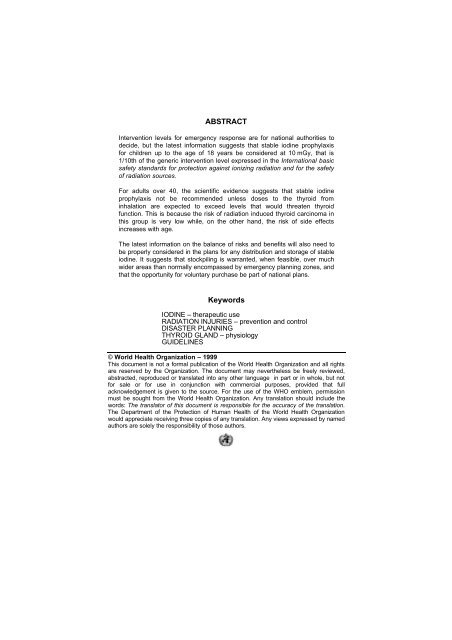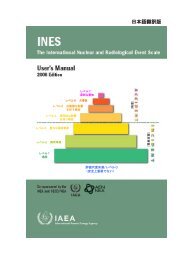Guidelines for Iodine Prophylaxis following Nuclear Accidents
Iodine_Prophylaxis_guide
Iodine_Prophylaxis_guide
You also want an ePaper? Increase the reach of your titles
YUMPU automatically turns print PDFs into web optimized ePapers that Google loves.
ABSTRACTIntervention levels <strong>for</strong> emergency response are <strong>for</strong> national authorities todecide, but the latest in<strong>for</strong>mation suggests that stable iodine prophylaxis<strong>for</strong> children up to the age of 18 years be considered at 10 mGy, that is1/10th of the generic intervention level expressed in the International basicsafety standards <strong>for</strong> protection against ionizing radiation and <strong>for</strong> the safetyof radiation sources.For adults over 40, the scientific evidence suggests that stable iodineprophylaxis not be recommended unless doses to the thyroid frominhalation are expected to exceed levels that would threaten thyroidfunction. This is because the risk of radiation induced thyroid carcinoma inthis group is very low while, on the other hand, the risk of side effectsincreases with age.The latest in<strong>for</strong>mation on the balance of risks and benefits will also need tobe properly considered in the plans <strong>for</strong> any distribution and storage of stableiodine. It suggests that stockpiling is warranted, when feasible, over muchwider areas than normally encompassed by emergency planning zones, andthat the opportunity <strong>for</strong> voluntary purchase be part of national plans.KeywordsIODINE – therapeutic useRADIATION INJURIES – prevention and controlDISASTER PLANNINGTHYROID GLAND – physiologyGUIDELINES© World Health Organization – 1999This document is not a <strong>for</strong>mal publication of the World Health Organization and all rightsare reserved by the Organization. The document may nevertheless be freely reviewed,abstracted, reproduced or translated into any other language in part or in whole, but not<strong>for</strong> sale or <strong>for</strong> use in conjunction with commercial purposes, provided that fullacknowledgement is given to the source. For the use of the WHO emblem, permissionmust be sought from the World Health Organization. Any translation should include thewords: The translator of this document is responsible <strong>for</strong> the accuracy of the translation.The Department of the Protection of Human Health of the World Health Organizationwould appreciate receiving three copies of any translation. Any views expressed by namedauthors are solely the responsibility of those authors.






